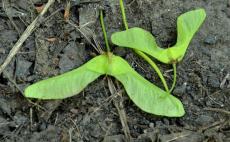Thu 30th Oct 2014Equine Atypical Myopathy cases dramatically rise this autumn Polo Times talks to Nicola Bell BVetMed MRCVS from Riverside Vets Equine about what signs to look for in your ponies Polo Times talks to Nicola Bell BVetMed MRCVS from Riverside Vets Equine about what signs to look for in your ponies
Atypical Myopathy is a highly fatal muscle disease, most commonly seen in young horses out to graze in autumn and spring, in both the UK and Northern Europe. It causes severe damage to muscles, affecting postural and respiratory muscles. Atypical Myopathy is attributed to the toxin Hypoglycin A, which is found in Sycamore seeds. The seeds can contain a variable amount of this toxin, so there is not necessarily a correlation between quantity ingested and severity of disease. Hypoglycin A interferes with muscle metabolism, and the breakdown of muscle tissues causes waste products to be released in high levels into the blood stream, which in turn results in kidney failure. Unfortunately there is no antidote available, so treatment consists of intravenous fluid therapy, pain relief and attentive nursing care – this is often best achieved via admittance to an equine hospital. The prognosis is very poor, and survival rates are reported as low as 26%.1 Nicola Bell reports to Polo Times that, “there have been an abnormally high number of cases reported this autumn.” Ms. Bell advises that the clinical signs to look out for include: weakness, muscle tremors, pain, lethargy, reluctance to walk, recumbancy (lying down with difficultly standing), discoloured urine (brown-red), difficulty breathing or swallowing. These are often confused with signs of colic. Prevention of the disease requires restricting horses from gaining access to Sycamore seeds; avoid pasture with Sycamore trees, fencing off areas where seeds/leaves have fallen. Reduce stocking densities down to ensure that there is enough grazing, or alternatively supplementing the pasture with extra forage. If you suspect a horse is suffering from Atypical Myopathy, contact your vet as a matter of urgency. Try not to move the horse as excessive movement may cause further muscle damage. If the horse urinates, try to collect a urine sample as this will aid the vet in their diagnosis. Removal of all other horses grazing on the same pasture and careful monitoring for clinical signs should be undertaken. Reference: 1. European outbreaks of Atypical Myopathy in grazing equines (2006–2009): Spatiotemporal distribution, history and clinical features, G. van GALEN et al, Equine Veterinary Journal Volume 44, Issue 5, pages 614–620, September 2012 Subscribe to Polo Times to read more veterinary articles and features on horse welfare issues http://www.polotimes.co.uk/?pg=40 Photograph: The classic Sycamore 'Helicopter' can be fatal for grazing horses
 | | Other top stories
 Mon 22nd Jul 2024 Mon 22nd Jul 2024
The British Open Polo Championship for The Cowdray Gold Cup Final
11-3 win for Dubai against La Dolfina Great Oaks
 Fri 19th Jul 2024 Fri 19th Jul 2024
Polo Times Sponsors 2024 Pony Club Polo Championships
Prizes, subscription discounts & coverage of Pony Club Polo
 Thu 18th Jul 2024 Thu 18th Jul 2024
La Dolfina Great Oaks & Dubai Reach Final
British Open Polo Championship for The Cowdray Gold Cup on Sunday 21 July
 Tue 16th Jul 2024 Tue 16th Jul 2024
Out-Sourcing Inc. Royal Charity Polo Cup Raises £1,000,000
 Mon 15th Jul 2024 Mon 15th Jul 2024
The British Open Polo Championship for the Cowdray Gold Cup Semi Finalists
La Dolfina Great Oaks vs King Power & Dubai vs Talandracas
 Fri 12th Jul 2024 Fri 12th Jul 2024
Thoroughbreds In Sport Polo Day
38 horses competed in three classes
 Thu 11th Jul 2024 Thu 11th Jul 2024
Cowdray Gold Cup Quarter Finalists Decided
Quarter Finals scheduled for 13 – 14 July
 Wed 10th Jul 2024 Wed 10th Jul 2024
Penalty Shootout Tomorrow to Determine Quarter Finals
La Dolfina Great Oaks, Dubai & Talandracas already qualified
 Fri 5th Jul 2024 Fri 5th Jul 2024
England Coronation Cup Team Confirmed
Argentina vs England on Saturday 27 July at Guards Polo Club
 Wed 3rd Jul 2024 Wed 3rd Jul 2024
AAP Announces Spring Season Dates
Triple Crown will begin on 24 September
 Tue 2nd Jul 2024 Tue 2nd Jul 2024
Polo Times July Issue Out This Week!
Packed with reports from across the UK & much more!
 Mon 1st Jul 2024 Mon 1st Jul 2024
Emlor Black Win Apsley Cup
Narrow 10-9 win against Aureus Polo
 Fri 28th Jun 2024 Fri 28th Jun 2024
British Open Polo Championship for the Cowdray Gold Cup
Results & Upcoming Fixtures
|

 Contact us
Contact us  Subscribe
Subscribe  Work for us
Work for us  All information is subject to copyright 2015
All information is subject to copyright 2015
 Contact us
Contact us  Subscribe
Subscribe  Work for us
Work for us  All information is subject to copyright 2015
All information is subject to copyright 2015